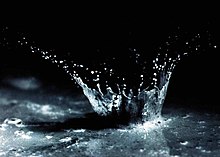User:Sanjanagopika/sandbox
Cite error: There are <ref> tags on this page without content in them (see the help page).

SOIL EROSION
Soil erosion is a naturally occurring process on all land. The agents of soil erosion are water and wind, each contributing a significant amount of soil loss each year.
Soil erosion may be a slow process that continues relatively unnoticed, or it may occur at an alarming rate causing serious loss of topsoil. The loss of soil from farmland may be reflected in reduced crop production potential, lower surface water quality and damaged drainage networks.
Intensive agriculture, deforestation, roads, anthropogenic climate change and urban sprawl are amongst the most significant human activities in regard to their effect on stimulating erosion.[1] However, there are many prevention and remediation practices that can curtail or limit erosion of vulnerable soils.
Physical processes[edit]
Rainfall and surface runoff[edit]

Rainfall, and the surface runoff which may result from rainfall, produces four main types of soil erosion: splash erosion, sheet erosion, rill erosion, and gully erosion.
Rivers and streams[edit]
Valley or stream erosion occurs with continued water flow along a linear feature. The erosion is both downward, deepening the valley, and headward, extending the valley into the hillside, creating head cuts and steep banks.
Factors affecting soil erosion[edit]
Climate[edit]
The amount and intensity of precipitation is the main climatic factor governing soil erosion by water.
Soil structure and composition[edit]
The composition, moisture, and compaction of soil are all major factors in determining the erosivity of rainfall. Sediments containing more clay tend to be more resistant to erosion than those with sand or silt, because the clay helps bind soil particles together.
See also[edit]
- Cellular confinement
- Coastal sediment supply
- Food security
- Geomorphology
- Groundwater sapping
- Highly erodible land
Notes[edit]
- ^ Julien, Pierre Y. (2010). Erosion and Sedimentation. Cambridge University Press. p. 1. ISBN 978-0-521-53737-7.
Further reading[edit]
- Boardman, John; Poesen, Jean (2006). Soil erosion in Europe. Wiley. ISBN 978-0-470-85910-0.
- Montgomery, David (October 2, 2008). Dirt: The Erosion of Civilizations (1st ed.). University of California Press. ISBN 978-0-520-25806-8.
- Montgomery, David R. (2007) Soil erosion and agricultural sustainability PNAS 104: 13268-13272.
- Brown, Jason; Drake, Simon (2009). Classic Erosion. Wiley.
- Vanoni, Vito A. (ed.). "The nature of sedimentation problems". Sedimentation Engineering. ASCE Publications. ISBN 978-0-7844-0823-0.
- Mainguet M. & Dumay F., 2011. Fighting wind erosion. One aspect of the combat against desertification. Les dossiers thématiques du CSFD. N°3. May 2011. CSFD/Agropolis International, Montpellier, France. 44 pp.

